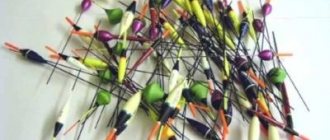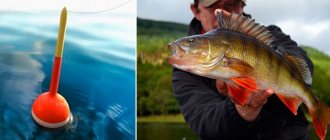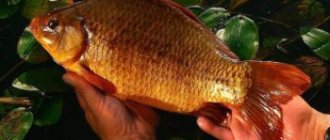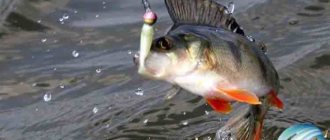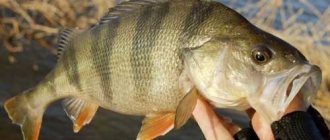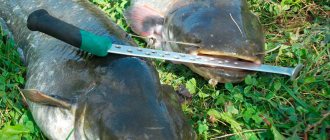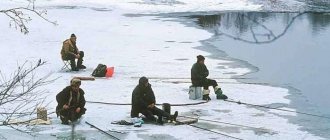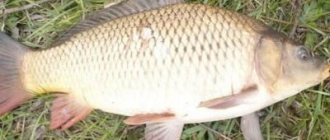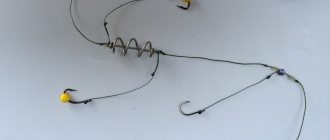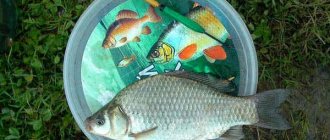Crucian carp is a fish of the carp family and lives almost everywhere throughout central Russia. Crucian carp feed on almost everything, from algae to worms and insects that have fallen into the water. The crucian carp that lives in the middle zone is usually medium-sized, but the crucian carp that lives in the lower reaches of the Volga sometimes reaches the size of a small carp. There are two varieties of crucian carp in the middle zone:
- Silver is not very large, covered with medium scales of light shades. Handles transportation well.
- Golden - slightly larger than silver, relatively large scales, yellow in shade. Does not tolerate transportation well.
Float tackle
Float tackle (or “float rod”) is perhaps the most popular and sporting tackle for catching crucian carp.
It consists of a rod, reel, fishing line, the float itself, a sinker and a hook with a nozzle. Float (nuances of choice). Since crucian carp is a capricious fish, you should choose the most sensitive float. The ideal option is a tube float, which is an oblong body with a line attachment at the lower end. Such floats have one drawback - it is difficult to select a sinker for them. If crucian carp is not the only purpose of fishing, you can take a heavier float.
The fishing line should be taken from 0.12 to 0.16 mm. However, if there is a chance of a large fish biting, the diameter can be increased to 0.2 - 0.25 mm. The shade of the fishing line does not play a special role, but it is preferable to use blue-green shades.
The hook should be taken No. 5-7 according to the domestic classification (6 – 10 according to the international classification). It is easy to distinguish between classifications: in the domestic one, the hook number is directly proportional to its size, in the international one - vice versa). As a nozzle you can use bread, maggot, worm, dough.
How to catch crucian carp with a float - read in this guide.
Also read the guide to all the fishing items that will come in handy when fishing with a float and other gear.
Rod
There are a few points to highlight here. I won’t talk about the types of rods for catching crucian carp and other fish and how the Bolognese, fly and match versions differ. I’ll tell you right away which I prefer.
I don’t use match rods or rods that require long casting. In most reservoirs you can do without them. The main controversial issue is the choice between a fly rod and a standard Bolognese rod. My choice is the classic version of a fishing rod with rings.
The advantages of the flywheel option are quite dubious for me. The disadvantages outweigh them. The Bolognese fishing rod is more convenient and does not cause problems. Fishing should be a simple and relaxed process. When using a regular fishing rod with rings, you can easily cut off a piece of twisted fishing line, remake the equipment, retie the hook, and so on. A fly rod involves the use of equipment pre-wound on a reel. For example, I prefer to cut off a piece of fishing line after each fishing trip or directly on it. In the case of a fly fishing rod, 5-6 meters of fishing line should simply be thrown away, and storing the equipment separately, winding and unwinding and other features do not appeal to me.
Another point is that depending on the conditions, the reservoir, the depth and other factors, I may need a completely different amount of fishing line. There is a difference between fishing at a depth of 30 cm or 3 meters. A fly rod does not allow you to do this. In any case, I fully accept both of these rod options. I also see no reason for controversy. Choose what you like. If you are a supporter of exclusively fly rods, read below after the subsection on reels.
So, let's focus on the Bolognese fishing rod with rings. The cost of such fishing rods starts from literally 180 rubles. I still prefer not the cheapest rods. But it is worth noting that the simplest fiberglass model with silver rings (probably everyone has seen such fishing rods) is quite possible to catch fish. But the maximum length of this option, with which you can fish normally, is 4 meters. 5 or more meters are just logs, I absolutely recommend buying them.
Rods with carbon elements are much thinner and lighter. You can freely use such options with a length of 5-6 meters. I have seen many identical fishing rods with different inscriptions and brands, they are sold almost everywhere. You can see the photo of the fishing rod I bought recently on the right. The cost of such models can vary greatly and range from almost 500 to 1500 rubles, although they will not differ at all. Pay no more than 900 rubles.
Feeder tackle
The feeder rod (detailed article on how to choose) should be chosen depending on the conditions (reservoir, weather).
So, for large bodies of water with strong currents (rivers, reservoirs), a tackle with a large rod weight of up to 120 g is suitable. For small bodies of water, a tackle with a rod up to 60 g and a small feeder is suitable. Rods with a length of 3.5 - 4 meters are the most versatile and have a good price-quality ratio. When choosing a feeder, you should take products weighing slightly less than the test rod, since the rest of the weight will be “taken” by the bait. The bait should also correspond to the reservoir (recipes for crucian carp bait). When fishing on a body of water with a strong current, the bait should be dense enough so that it does not wash away, and on reservoirs with a weak current or standing water - as light as possible so that it does not sink in the muddy bottom. For the latter option, a base of breadcrumbs is suitable.
To prevent the fish from quickly getting enough and thus losing interest in the bait, the components of the bait must be small. Crucian carp do not have specific taste preferences, so there can be no unambiguous and clear advice on how to make bait. For scent, you can add a little grated garlic, ground seeds, vegetable oil or even ground cookies to the bait.
Baits. As with bait, there is no advice on what to fish with. The taste preferences of crucian carp can change even during the day. We can only say that crucian carp bite well on pearl barley, pasta, corn, pancakes, and rye bread dough flavored with garlic.
A fishing line with a cross section of 0.12 mm is suitable. If there is a chance of carp or other strong fish biting, it is better to take a fishing line of about 0.2 mm. The leash should be made in this case from a thinner fishing line. The nozzle should be such that small things like roach or bleak cannot swallow it. It is better to use hooks from No. 5 – 7 to No. 9. The latter is suitable for large crucian carp. Also, the hooks should be as sharp as possible, otherwise there may be problems with hooking fish.
Tops (quivertips) , like other tackle, should be selected depending on the conditions. In the current and in the wind, the tip should not be very sensitive so as not to react to these factors and not create false bites. When fishing on a still body of water in calm weather, it should be more sensitive so that the angler can see even the most sluggish bite.
The simplest equipment for crucian carp is a paternoster.
The technique of catching crucian carp with a feeder is described in the corresponding article on our website.
What fishing methods are there?
When catching crucian carp, no innovative methods are used, so they are no different from catching the same bream. Another thing is what gear to use, from fishing line to rod length.
Float rod
One of the most common and used fishing methods. There is nothing complicated about it, so it’s perfect even for a beginner. All you need is:
- Float rod 5-7 meters long
- Line with a diameter of 0.18-0.20. Such an impressive diameter is due to the fact that the rig uses a leader, so the thickness of the main line does not play a decisive role
- Leash made of monofilament or fluorocarbon with a thickness of 0.12-0.14 mm
- Hook from No. 6 - No. 10 according to the international classification or 5-7 according to the domestic one
Standard float rod equipment:
- A fishing line is tied to the reel and passed through all the rings of the rod
- The float is mounted through a ring on the float or using a cambric. When fishing in still water and in windless weather, 2-4 grams is enough. In the presence of waves and wind, its carrying capacity is increased. The best shape with an elongated thin body, long antenna and keel. Such a float will perfectly transmit even cautious bites.
- Next, the weights are mounted. It is necessary to use 3-4 weights, of which the lightest will be closer to the hook. When biting, the fish does not feel resistance, so it takes the bait more confidently.
- A hook size 6-10 is crocheted; we recommend using a clinch knot for this - it is reliable and simple.
- Read a detailed article about catching crucian carp with a float rod
Feeder
The rod is selected depending on the fishing conditions. But since our article is intended for beginners, use what you have for these purposes. If you are thinking about purchasing, you need to decide where you will fish more often: on a lake, a small river, a reservoir or a large river.
This will determine the length of the form you choose. The larger the body of water, the longer the rod is desirable (2.7-3.5 m), it will allow you to make long casts. The 40-60 g test is universal and suitable for all types of reservoirs. On big water we recommend 120 gr.
Feeder equipment:
- The reel is inertia-free with a spool size of 2000-4000. When fishing on a small river or lake with short casts, a size of 1500 is sufficient
- Braided fishing line with a diameter of 0.10-0.12 mm. Monofilament 0.18-0.20 mm
- Leash made of fishing line or fluorocarbon with a diameter of 0.12-0.14 mm
- Hooks with numbers from 6-10
- The top of the feeder is placed depending on the current and the weight of the feeder. In still water and low currents, the most sensitive color (green color) is used. The stronger the current and the heavier the feeder, the stronger and harder the quivertip is placed.
Tackle “killer” crucian carp
Read the whole article dedicated to crucian carp killer gear and familiarize yourself with its contents. It describes in detail the process of making a house, with all the subtleties. It consists of 3 spring feeders connected in series, with 3 leashes, each of which has a hook. The tackle performs well not only when catching crucian carp, but also other whitefish, including bream.
Spring
A spring is the shape of a feeder, which in all its parameters corresponds to the name (in the photo above, springs are used in the “killer” crucian carp gear). The only difference is that a more viscous bait is used so that it does not wash out very quickly. The design is self-cutting, which is a big plus for a beginner.
A spring with 3-4 leads is mounted to a piece of cord or thick fishing line. Leashes can be made from the same monofilament/cord or from a thinner section. Bloodworms, worms, maggots, and polystyrene foam are used as bait. Due to the large number of hooks, the fisherman has a greater chance of catching crucian carp.
Makushatnik
A makushatnik is a special tackle for fishing using cake.
Usually carp are caught with it, but sometimes crucian carp is also caught with it. In view of this, it is possible to catch crucian carp with it purposefully. Fishing for crucian carp on top has several features. Bottom fishing rods from a spinning rod are often used as gear, but more professional fishermen use feeders.
- You can use a crucian carp bait together with makukha – the most commonly used are worms and granules. Worms can be used either as dung or crawling worms, which can be found in the city or bought at a fishing store, or as “shore” worms, which can be obtained directly on the spot. Granules are used in anise, dill, hemp, corn, raspberry or strawberry flavors. The granules are placed two per hook.
- You can also use regular carp rigging, hooks can either be placed in the cake or left free. You can buy the cake flavored or flavor it yourself. Anise, hemp, dill and strawberries are suitable.
Nipple tackle
Almost all types of spinning tackle are suitable for this method of fishing: any reels and fishing lines with a cross-section of up to 0.6 mm.
Viscous bait is stuffed into the feeder and hooks are stuck into it. “Millet dough” can be used as bait, as well as bait. To do this, the millet is steamed in a water bath and then rolled out like dough. Then add semolina or special bait. You can also use a mixture of ground white and black bread pulp and boiled potatoes. This nozzle should have a consistency similar to plasticine. You can also use rolled oats. The attachment must last for at least 10 hours.
This method, although effective, is unsportsmanlike. A self-hatched fish is pulled out of the reservoir. In addition, it takes quite a long time before the bite occurs, unlike with feeder gear. Read the feeder guide for beginners and understand all the delights of sports feeder fishing.
Feeder tackle for fishing
Considering that the crucian carp has gone wrong today, the gear for catching this wrong crucian carp should be of different standards. As a win-win option, you can choose a relatively universal feeder model with a length of 3.6-3.9 m , where the range of test indicators is from 60 to 120 g . Most often having a not very rigid action, the rod is capable of precise casting, clear hooking and at the same time it is quite soft. This 3.9 m long rod is quite suitable for feeder fishing on a river with a fairly strong current. But even at the exit from the oxbow lakes, at the mouths of streams, rivulets and other places where the casting of the tackle falls on the border of the stream and the reverse current, a rod of this class of medium will be in hand and in place.
Feeders can also be placed weighing 40 g , taking into account the volume of bait. These indicators are recommended, of course, for river fishing in the current. The shape of the feeders should be angular to better hold on to the current. These are usually cage feeders or triangular feeders. For fast currents, 120 grams are most suitable . For particularly strong currents and long casting, extra-heavy class gear is required. But this is not for everyone. Most often, crucian fishermen make do with gear with average performance.
Spring
A spring is an analogue of a nipple, but viscous bait is used on a spring rig. The leash to the feeder is made of a cord, since, unlike monofilament, it has no memory. The length of the leash is 5–7 cm. The hooks are left open, and a foam ball is put on the hooks themselves, the size of which is selected to fit the hook. It is best if the lifting force of the ball balances the weight of the hook, so it will be, as it were, suspended in the water and will sway as it vibrates within the layers.
Of the other characteristics, only the weight of the feeder is of significant importance. The larger it is, the greater the likelihood of self-hooking. This tackle is also unsportsmanlike, since the fish are hooked due to the inertia and weight of the feeder.
Rubber
An elastic band is a bottom tackle that has a piece of aircraft model rubber as a shock absorber. We have a detailed article about this type of fishing. When pulling the fishing line out of the water, the elastic band stretches, this saves time on “reloading”, since there is no need to cast the tackle again, thereby scaring away the fish. The sinker must be taken heavy so that the elastic does not pull it out of the water when stretched.
To determine the bite, use a guard or use coastal vegetation instead. Bread, corn, worms or dough are used as bait for crucian carp. This tackle can be left overnight, and in the dark the likelihood of a bite increases. It is not recommended to leave the gear overnight if the trip is not overnight or if the house is far from the reservoir.

